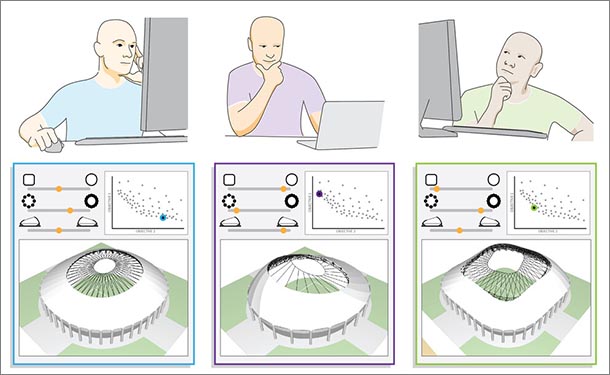
Expert designers will be studied using eye tracking software as they complete an architectural challenge. IMAGE: STEPHANIE BUNT
Better, sustainable early building designs may be possible with NSF grant
8/19/2021
By Erin Cassidy Hendrick
UNIVERSITY PARK, Pa. — In the past, when conceptualizing a new building, architects would create designs by hand, mostly using their experience and creativity. Increasingly, software programs are being used at the onset, which can help guide the initial design to be high-performing, sustainable and resilient through validation and optimization.
To better understand this early design process, Penn State’s Nathan Brown, assistant professor of architectural engineering, and Catherine Berdanier, the Clyde W. Shuman Jr. and Nancy Shuman Early Career Assistant Professor of Mechanical Engineering, received a $316,623 grant from the National Science Foundation.
“The industry is using simulations more and more to make early design decisions,” said Brown, the project’s principal investigator. “But we don’t have systematic knowledge of what the best designer behaviors are. We want to gather empirical data from expert designers on how they solve these problems and use that to move the field forward.”
In the project, they plan to study how expert designers use software during the iterations of their work, giving architectural engineers a larger voice in the conversation and potentially designing better, more sustainable buildings.
“Simulations offer a medium for that collaboration,” Brown said. “If engineers are able to be flexible while generating and quantitatively evaluating different options, this can facilitate a more productive conversation between architects and engineers.”
Brown and Berdanier will recruit 10 expert-level designers and present them with an authentic design challenge, such as a stadium with low operational energy costs and unique acoustic characteristics. While these experts, who may be architects or engineers with specialized computation skills, are creating their designs, the researchers will use eye-tracking software to collect physiological data and observe how the designers use the software to complete the challenge. They will then conduct follow-up interviews to understand the designer’s reasoning and rationale for their approach.
“In these designs, art and science mix,” said Berdanier, the project’s co-principal investigator. “These expert designers lie at that intersection. From an educational standpoint, if we can capture what this expert-level experience looks like, we can translate some of these best practices into university coursework and our students will enter the workforce more prepared.”
The researchers plan to apply the findings of this research to guide undergraduate- and graduate-level courses in architectural engineering and develop workshops for mid-career professionals.
“There is a huge advantage in having empirical, rigorous research governing these training opportunities,” said Berdanier, whose research focuses on improving engineering education. “If I am only teaching something the way I learn something best, it propagates my biases and reaches one set of people — those who think like me. With data and empirical studies justifying how and why we are teaching design processes, we can be more effective for every learner.”



